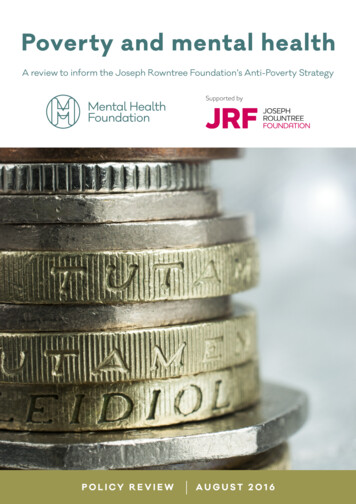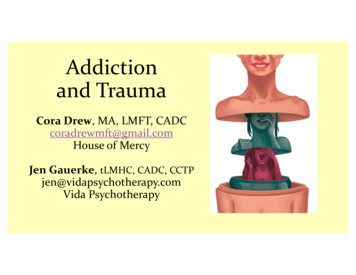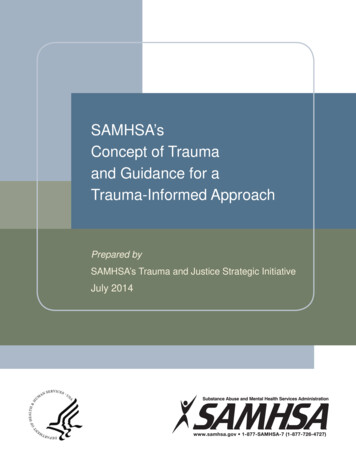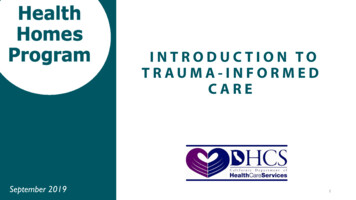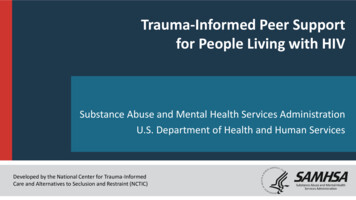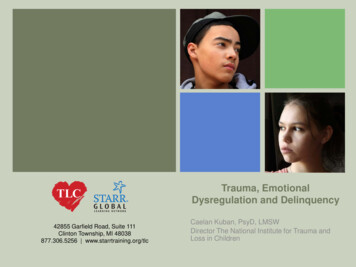
Transcription
Trauma, EmotionalDysregulation and Delinquency42855 Garfield Road, Suite 111Clinton Township, MI 48038877.306.5256 www.starrtraining.org/tlcCaelan Kuban, PsyD, LMSWDirector The National Institute for Trauma andLoss in Children
About TLC Training Trauma Certification Books and Tools Parent TraumaResource Center Online Courses(Continuing educationcredits)Summer ConferenceJuly 14 – 18, 2014The Lansing Centerwww.starr.org
Agenda Brief Review How trauma has a significant impact on emotionalregulation Why trauma/dysregulation leads to delinquency What can we do to help? Case Examples Activities to use
ReviewBeing trauma informed means asking:“What has been this child’s lifeexperience?”NOT“What is wrong with this child?”
ReviewTRAUMA Any incident or experience that leaves aperson feeling hopeless, helpless andunable to do anything about their safety,situation or life can be traumatizing.The incident/experience can involveeither REAL or even PERCEIVED threat.
ReviewTHE IMPACT OF TRAUMA (Psychophysiology ofTrauma) The most adverse impact following trauma is thedisruption the body’s physiology that impairsemotional regulation. The stress response impacts the brain in ways thatmake controlling emotions and behavior difficult.
ReviewWHAT HAPPENS?Trauma sends an alarmthroughout the body, tensingmuscles for action.Surges in stress hormonesimpact the ability to cope withstress, manage emotions andcontrol impulses.This doesn’t just happen andthen stop – it is anexaggerated and prolongedresponse and that is why it isso harmful!
ReviewImpaired RegulationImpaired emotional regulation Developmentof dysfunctional coping mechanisms that take the formof and present as: Oppositional behaviors Defiant behaviors Aggressive behaviors Substance abuse Rule-breaking behaviors
ReviewIt is hard to accesslanguage when weare stressed andeven more so whenwe are experiencingextreme and chronictrauma.
ReviewIt is hard to accesshigher level thinking(problem solving,impulse control anddecision making)during stress andtrauma.
Trauma and Delinquency Link Some propose that the links between trauma and delinquencyare a function of EMOTIONAL NUMBING as a strategy toregulate overwhelming distress. This in turn causes an increase in the likelihood of behavingin maladaptive ways and can result in adjudication (Lansfordet al, 2006; Ford et al, 2008).The prevalence of post traumatic stress among delinquentyouth is up to 8 times higher than in community samples(Wolpaw & Ford, 2004).
Trauma and DelinquencyOver 90% of delinquentyouth have experienced anaverage of 14 distincttraumas in his or her lifetime(Abram et al., 2010).Significant relationshipbetween maltreatment anddelinquency was found indata collected from 1,200youth.
Trauma and DelinquencyInterpersonal violence exposure increases risk for PTSDsymptoms, depression, binge drinking and delinquency (Cisleret al., 2012).Multiple trauma exposure increased risk for violenceperpetration (Duke et al., 2010).Family conflict, school isolation increase vulnerability todelinquency (Ford et al., 2006).The disruption in emotional regulation can resultin increased delinquency rates.
So, you are beginning to see the cycle,right?
Trauma and Juvenile Delinquency“While this survivalcoping may appearcallous and defiant, itis often a cry for help”(Ford et al, 2006)
Emotional Dysregulation Alexythymia Difficulty identifying and labeling emotions. Difficulty communicating feelings to others. Heightened emotional states Limited understanding about emotions Reactivity and sensitivity to stressors Maladaptive management tactics for emotional episodes
Dysregulation and TraumaFord et al., 2006 – StudyDescribes the common pathway from trauma to delinquency basedupon research and data from over 50 research studies. findings suggest court ordered sanctionsand services that address emotionaldysregulation can play a vital role in helpingchildren Recover from trauma Reduce futurerecidivism
Emotional NumbingEmotional numbing is a common way to cope withthe intensity of dysregulation.What is the number 1 wayyouth numb out?
Substance Abuse Over half of all adjudicated youth with posttraumatic stresshave two or more types of comorbid disorders Substance abuse is the most common comorbid disorderamong youth posttraumatic stress. Substance abuse in youth is related to severity of offensesand is often implicated in the arrests. 4/5 youth arrests involve adolescents who are under theinfluence of drugs and alcohol (Kerig & Becker, 2010).
This is the basic cycle.How can we interrupt this?Trauma Dysregulation Delinquency
Do not focus on BehaviorsWe need to focus on what is driving the behaviors.Underneath the behaviors is the worry, hurt, fear, anger, lackofsafety and victim thinking from the trauma.We need to focus on the themes of trauma – theseoverwhelming feelings and sensations are what is driving thebehavior.How do we do this?
EMOTIONAL REGULATION!!!
Emotional RegulationEmotional regulation can play a vital role in helpingyouth RECOVER from traumavictimizationREDUCE the likelihood ofrecidivism
Mind-body integrated therapies Emotional RegulationTechniques to engage both thebody and the mind. Sensory-based,Mindbody treatmentsengage clients – theydon’t focus onTALKING.
Mind-Body SkillsThere is evidence that usingmind-body interventionshelp develop overallregulation in the brain(Corcoran et al, 2010; Farbet al, 2010; Siegel, 2007)Teaching traumatizedyouth to observe andname their bodysensations, which are thefirst signs of emotion,improves regulation.
Mind Body SkillsMind Body Skill activitiesinclude: Breathing Mindfulness Guided imagery Expressive arts(sensory basedactivities)ALL integrated withTrauma Themes
Breath workConscious alterationof breathing, such asconnecting the inhaleand exhale Increased heart ratevariability Decreased blood pressurerates Decreased respiratoryrates (Forfylow, 2011) Reduction in anxiety(Kozasa et al, 2008) Reduction in depression,anxiety and PTSDsymptoms (Descilo et al,2010)
Breath work Activity Ideas
MindfulnessThe moment-tomoment awarenessof one’s experiencewithout judgmentWhen you are in thepresent, helps move awayfrom re experiencing, youmove towards becomingunstuck.Decreases rumination, worryabout what happened inpast and what might happenlater .
Mindfulness Develops affect regulation(Davis & Hayes, 2011). Cognitive flexibility,enhanced emotionregulation, reducedrumination (Kimborough,2010) Improves emotionalawareness, tolerance andacceptance of distressfulsymptoms (Borman et al.,2012) Improves self-regulationand emotional flexibility(Carmody et al., 2009) Improves emotionalawareness and higherlevels of emotiondifferentiation for bothpositive and negativeemotions (Hill & Updegreff,2011)
Mindfulness Activity Ideas
Guided ImageryThe use of relaxation and mental visualization to improvemood and/or well-being. Helpschildren interrupt intrusive, distressingthoughts (Miller & Johnson, 2012). Teaches children that they can gain controlover their thoughts and feelings (Margolin,2007).
Guided Imagery Combine theguided imageryactivity with adrawing orexpressive artactivity
Expressive ArtsDrawing, painting, collage, music, drama Reduction of hyper-arousal (Irwin, 2006) Facilitates expression of emotion (Hayes &Greco, 2008) Improves self awareness and emotionalregulation (Coholic, 2011) Decreases in hopelessness (Staples et al.,2011)
Expressive ArtsSculpture ofHURT
Journaling
Recent ResearchTrauma Intervention Program combined withmind-body skill activitiesTraumatized and Adjudicated YouthWayne CountyMichigan
Recent Research ResultsYouth were screened using the TLC Life Event Checklist (LEC) –all had multiple trauma exposure and experiencesAt intake and discharge, youth completed: TLC PTSD Adolescent Questionnaire (CAQ) Social Emotional Assets and Resilience Scale – Adolescents(SEARS-A) Scale of Body Connection (SBC)At discharge and then again two months after completion ofprogram youth were asked to identify recidivism since intake.
Findings - CAQ40Severity Score35302537.335201534.219.2 21.51017.750Pre InterventionPost InterventionSubcategories of PTSDReexperiencingAvoidanceArousal
Findings – Scale of Body Connection3.53Scores2.521.52.932.810.501.16Pre Internvention1.1Post InterventionScale of Body ConnectionBody AwarenessBody Dissociation
Findings – e Intervention56.753.3Self RegulationSocial CompetenceEmpathyResiilencePost InterventionSocial Emotional and Resilience Scale Categories
Recidivism - FindingsRecidivism rates wereimproved by 90% ofparticipants.Self-reported at twomonth post interventionno further contact withthe juvenile justicesystem.
Summary Trauma Symptomsdecreased Self-Regulation improved Body Awarenessimproved Body Dissociationdecreased Recidivism rates reduced
Case Examples
Michael’s Story15 year old maleContact with court:incorrigibility, stealing,fighting, truancy.One of 8 biological childrenParental rights of Michael’smother terminated whenMichael turned 8 years oldIt is unknown where Michael’sfather isBirth – 8 years old: significantpoverty and neglect8 years – current: separatedfrom siblings, multiple fostercare placementsLiving in a foster home now
Michael’s StoryMichael’s self report:“I am always the target I am jumped by members of a gang Ididn’t want to join.”“I skip school because I really don’t want to get jumped.”“I smoke weed some but I do because it helps me to relax andescape from the worry of being beat down.”
What do you think your strengths are?“I am really good with kids – I’m patient withmy younger siblings in my foster home.’“I pray, I am close with God.”“I believe that God keeps me and my realfamily connected.”
Michael’s Pre/Post CAQCAQPRE INTERVENTIONPOST l4410
Michael’s Pre/Post Briere TSCCTSCCPre InterventionPost c Stress161Dissociation90
Michael’s Pre SEARS-AScaleScore PREScore LevelSelf Regulation5High RiskSocial Competence4High RiskEmpathy2High RiskResponsibility12At RiskTotal Score23High Risk
Michael’s Pre/Post SBCScalePre InterventionPost InterventionBody Awareness.51.9Body Dissociation2.81.1
Michael’s AngerFlames, burning and tears.“This is my anger about my sisterand I being removed from ourmother’s home.”“Then, I was so angry but alsovery scared and confused.”“Now, I am really just mad – I amso mad that I can’t see mysister – I don’t even knowwhere she is.”
How Michael coped in the past“See this tattoo?”Michael showed me a tattoo onhis right arm of hands in theprayer position.“It covers up all the scars I haveon my arm from when I used tocut my arm with razor blades.”“I don’t cut anymore, I’m lucky Ididn’t die from cutting.”
How Michael copes nowSmoking makes me feel chill.I smoke blunts with my friends.It helps me to stay calm and notthink about my worries.What are your worries?That my mother is glad we all gottaken awayI worry about getting jumpedanytime
Interventions Michael LikedWriting (mostly prayers)Tense/Relax Activities
Happy Memory: Christmas“The best memory of my life”
Michael’s Pre/Post CAQCAQPRE INTERVENTIONPOST l4410
Michael’s Pre/Post Briere TSCCTSCCPre InterventionPost c Stress161Dissociation90
Michael’s Post SEARS-AScaleScore PREScore LevelSelf Regulation27AverageSocial Competence8At RiskEmpathy9At RiskResponsibility22AverageTotal Score66At Risk
Michael’s Pre/Post SBCScalePre InterventionPost InterventionBody Awareness.51.9Body Dissociation2.81.1
Shayna’s Story14 year old, only childCourt contact: Charged with multiple possessions and selling ofmarijuana, school/home truancyHistory of abuse, neglect. Mother is a drug addict.Currently lives with Grandmother.Mother is in treatment for her addiction and they have littlecontact with one another.
What do you think your strengths are?“I’m really pretty.”“I have a great body.”“I’m smart but nobody really knows that aboutme.”“I have a great imagination.”“I know how to read people.”
Shayna’s Pre/Post CAQCAQPre InterventionPost 3913
Shayna’s Pre/Post TSCCTSCCPre InterventionPost InterventionAnxiety106Depression144Anger225Post Traumatic Stress174Dissociation205
Shayna’s Pre SEARS-AScaleScore PREScore LevelSelf Regulation9At RiskSocial Competence4High RiskEmpathy2High RiskResponsibility12At RiskTotal Score27High Risk
Shayna’s Pre/Post SBCScalePre InterventionPost InterventionBody Awareness1.12.8Body Dissociation1.71.1
What happened/Who caused it?My uncle raped me when I was 5years old.I could not escape.This is actually not my uncle, it ismy Dad – it is his fault becauseif he would have been in mylife, none of this would haveever happened
What the hurt is like
Where the hurt is in my body
Shayna’s Anger/Sadness
How Shayna CopesShayna smokes marijuana and cigarettes to “escape”.
Interventions Shayna LikedMandalasGuided Imagery with Drawing
Shayna’s Pre/Post CAQCAQPre InterventionPost 3913
Shayna’s Pre/Post TSCCTSCCPre InterventionPost InterventionAnxiety106Depression144Anger225Post Traumatic Stress174Dissociation205
Shayna’s Post SEARS-AScaleScore POSTScore LevelSelf Regulation33Average to High FxnSocial Competence12At RiskEmpathy11At RiskResponsibility19AverageTotal Score74Average
Shayna’s Pre/Post SBCScalePre InterventionPost InterventionBody Awareness1.12.8Body Dissociation1.71.1
Summary
Summary
Trauma, Emotional Dysregulation and Delinquency . Caelan Kuban, PsyD, LMSW . Director The National Institute for Trauma and . History of abuse, neglect. Mother is a drug addict. Currently lives with Grandmother. Mother is in treatment for her addiction and they have little





